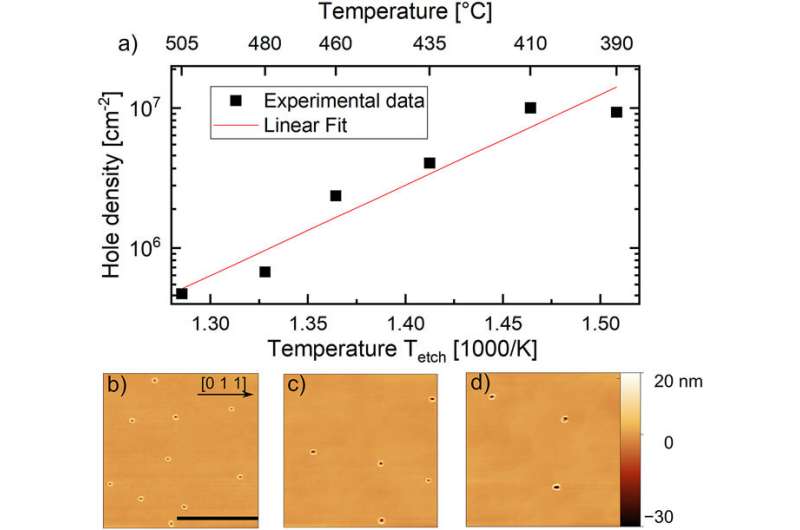This article has been reviewed according to Science X's editorial process and policies. Editors have highlighted the following attributes while ensuring the content's credibility:
fact-checked
peer-reviewed publication
proofread
Researchers manufacture first-ever droplet-etched quantum dots that glow in C-band optical light

Paderborn researchers from the Department of Physics and the Institute for Photonic Quantum Systems (PhoQS) have succeeded in manufacturing quantum dots—nanoscopic structures where the material's quantum properties come into play—that glow in the optical C-band at wavelengths of 1530 to 1565 nanometers.
This is particularly special as it is the first time that quantum dots like these have been manufactured by the local droplet etching and subsequent filling of nanoholes in an indium aluminum arsenide / indium gallium arsenide system lattice-matched to indium phosphide substrates.
In the future, these quantum dots could for example be used as a source of entangled photons, which might be relevant for innovative encryption systems involving quantum technologies. Luminescence in the optical C-band is particularly relevant here: slowdown in fiber optic networks is minimal at this wavelength, enabling potential future use with the current network. The researchers have now published their findings in the journal AIP Advances.
The team, consisting of Dennis Deutsch, Christopher Buchholz, Dr. Viktoryia Zolatanosha, Prof. Dr. Klaus Jöns and Prof. Dr. Dirk Reuter, etched nanoholes in an indium aluminum arsenide surface and filled them with indium gallium arsenide.
"One critical element of manufacturing quantum dots, if they are to be used for generating entangled photons, is lattice matching. If this is not performed, it causes tension in the quantum dot, which can dispel the quantum mechanical entanglement of the photons generated," Denis Deutsch explains.
Manufacturing quantum dots by filling droplet-etched holes is not new, but unlike in previous processes, the researchers used lattice matching to indium phosphide rather than gallium arsenide. The change of material enabled them to achieve emission in the C-band. As well as lattice matching materials, the symmetry of quantum dots is also a key factor in their suitability as an entangled photon source. The publication therefore also statistically evaluated and examined the symmetry of numerous holes manufactured using different parameters.
This is a long way from being technically implementable, but the method is already demonstrating its potential for manufacturing quantum dots. This is because in the future, quantum computing is likely to be far superior to traditional computers when it comes to encryption.
The phenomenon of entanglement is a promising approach to securely exchanging encrypted data, as any attempts to eavesdrop are exposed thanks to the laws of physics. Since entangled photons are exchanged via fiber optic cables, it is essential that transmission should be as low-loss as possible. "Manufacturing photons in the particularly low-loss optical C-band is therefore a major step forward in encryption using entangled photons," Deutsch concludes.
More information: D. Deutsch et al, Telecom C-band photon emission from (In,Ga)As quantum dots generated by filling nanoholes in In0.52Al0.48As layers, AIP Advances (2023). DOI: 10.1063/5.0147281
Journal information: AIP Advances
Provided by Universität Paderborn



















